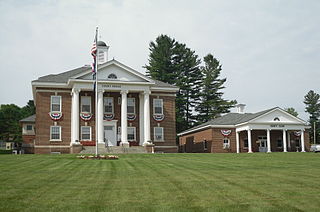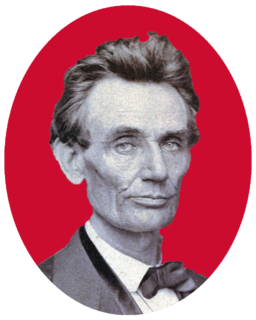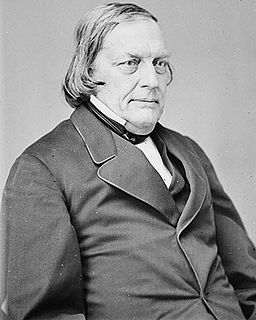
The 1860 United States presidential election was the 19th quadrennial presidential election. It was held on Tuesday, November 6, 1860. In a four-way contest, the Republican Party ticket of Abraham Lincoln and Hannibal Hamlin emerged triumphant. The election of Lincoln served as the primary catalyst of the American Civil War.

Hamilton County is a county in the U.S. state of New York. As of the 2010 census, the population was 4,836, making it the least populous county in New York. Its current population is 4,416. Its county seat is Lake Pleasant. The county is named after Alexander Hamilton, the only member of the New York State delegation who signed the United States Constitution in 1787 and later the first United States Secretary of the Treasury. The county was created in 1816 and organized in 1847.

Grafton is a town in Rensselaer County, New York, United States. The population was 2,130 at the 2010 census. It is believed that the town received its name from Grafton, Vermont, where the first town supervisor, Nathaniel Dumbleton, was originally from. The town is an interior town near the north-central part of the county. NY Route 2 passes across the town.

The 1860 Republican National Convention was a presidential nominating convention that met from May 16 to May 18 in Chicago, Illinois. It was held to nominate the Republican Party's candidates for president and vice president in the 1860 election. The convention selected former Representative Abraham Lincoln of Illinois for president and Senator Hannibal Hamlin of Maine for vice president.

Elections to the United States House of Representatives for the 37th Congress were held at various dates in different states from August 1860 to October 1861.

The Thirty-sixth United States Congress was a meeting of the legislative branch of the United States federal government, consisting of the United States Senate and the United States House of Representatives. It met in Washington, D.C. from March 4, 1859, to March 4, 1861, during the third and fourth years of James Buchanan's presidency. The apportionment of seats in the House of Representatives was based on the Seventh Census of the United States in 1850. The Senate had a Democratic majority, and the House had a Republican plurality.

The United States Census of 1840 was the sixth census of the United States. Conducted by the Census Office on June 1, 1840, it determined the resident population of the United States to be 17,069,453 – an increase of 32.7 percent over the 12,866,020 persons enumerated during the 1830 Census. The total population included 2,487,355 slaves. In 1840, the center of population was about 260 miles (418 km) west of Washington, near Weston, Virginia.

The United States Census of 1810 was the third Census conducted in the United States. It was conducted on August 6, 1810. It showed that 7,239,881 people were living in the United States, of whom 1,191,362 were slaves.

The United States Census of 1830, the fifth census undertaken in the United States, was conducted on June 1, 1830. The only loss of census records for 1830 involved some countywide losses in Massachusetts, Maryland, and Mississippi.

The United States Census of 1860 was the eighth Census conducted in the United States starting June 1, 1860, and lasting five months. It determined the population of the United States to be 31,443,322, in 33 states and 10 organized territories. This was an increase of 35.4 percent over the 23,191,876 persons enumerated during the 1850 Census. The total population included 3,953,762 slaves.

The United States Census of 1870 was the ninth United States Census. It was conducted by the Census Bureau from June 1, 1870 to August 23, 1871. The 1870 Census was the first census to provide detailed information on the African-American population, only five years after the culmination of the Civil War when slaves were granted freedom. The total population was 38,925,598 with a resident population of 38,558,371 individuals, a 22.6% increase from 1860. The 1870 Census' population estimate was controversial, as many believed it underestimated the true population numbers, especially in New York and Pennsylvania.

George Washington Patterson was an American politician in the U.S. State of New York. He served as a member of the United States House of Representatives and as Lieutenant Governor of New York during the 1800s.

The 1861 United States Senate election in New York was held on February 5, 1861, by the New York State Legislature to elect a U.S. Senator to represent the State of New York in the United States Senate.

The United States Senate elections of 1858 and 1859 were elections which had the Republican Party gain five additional seats in the United States Senate, but the Democrats retained their majority. That majority would erode in 1860 with the secession of the southern states leading up to the Civil War. In Illinois, incumbent Stephen A. Douglas (D) and challenger Abraham Lincoln (R) held a series of seven debates, known as the "Lincoln–Douglas debates."
The United States Senate elections of 1860 and 1861 were elections corresponding with Abraham Lincoln's election to the presidency. The nascent Republican Party increased their Senate seats in the general elections, and after southern Democrats withdrew to join the Confederacy, Republicans gained control of the United States Senate. To establish a quorum with fewer members, a lower total seat number was taken into account.

The 1860 United States presidential election in Pennsylvania took place on November 6, 1860, as part of the 1860 United States presidential election. Voters chose 27 representatives, or electors to the Electoral College, who voted for president and vice president.

The 1856 United States presidential election in New York took place on November 4, 1856, as part of the 1856 United States presidential election. Voters chose 35 representatives, or electors to the Electoral College, who voted for president and vice president.

The 1860 United States presidential election in New York took place on November 6, 1860, as part of the 1860 United States presidential election. Voters chose 35 electors of the Electoral College, who voted for president and vice president.

The 1860 United States presidential election in New Jersey took place on 6 November 1860, as part of the 1860 United States presidential election. Voters in New Jersey chose 7 electors of the Electoral College, who voted for President and Vice President. New Jersey voters voted for each elector individually, and thus could split their votes. All seven electors were chosen in a single at-large election. That is, each voter voted for up to seven candidates, and the seven candidates with highest vote counts were elected.














